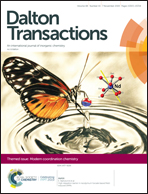Knock-on synthesis of tritopic calix[4]pyrrole host for enhanced anion interactions†
Abstract
Interactions of anionic guests with a tritopic peripherally functionalized conjugated calix[4]pyrrole host (1) prepared using a regioselective synthetic method is reported. The regioselectivity of synthesis relies on selective N-alkylation of the calix[4]pyrrole caused by peripheral substitution of one pyrrole group with subsequent N-alkylation at the opposing pyrrole group termed by us ‘knock-on’ regioselectivity. The resulting host molecule exhibits anion interactions with common chloride and nitrate anions enhanced by an order of magnitude over the parent conjugated calix[4]pyrrole. Combined analysis of 1H NMR and UV-vis spectroscopic titration data enabled an evaluation of binding strengths of anions with the host KA in a binding model where the salt dissociation process is also incorporated in the form of its dissociation constant Kd. Anions could be classified as two types based on their interactions with 1: Type A anions (chloride, nitrate, perchlorate, hydrogensulphate) associate as 1 : 1 complexes through hydrogen bonding while interactions involving Type B anions (acetate, fluoride, dihydrogenphosphate) are complicated by host deprotonation and/or countercation association. Hosts based on rim-functionalized calix[4]pyrroles such as 1 represent a promising new family of chromophores for estimation of biologically relevant anions or other species.
![Graphical abstract: Knock-on synthesis of tritopic calix[4]pyrrole host for enhanced anion interactions](/en/Image/Get?imageInfo.ImageType=GA&imageInfo.ImageIdentifier.ManuscriptID=C9DT02365H&imageInfo.ImageIdentifier.Year=2019)
- This article is part of the themed collection: Modern coordination chemistry


 Please wait while we load your content...
Please wait while we load your content...
